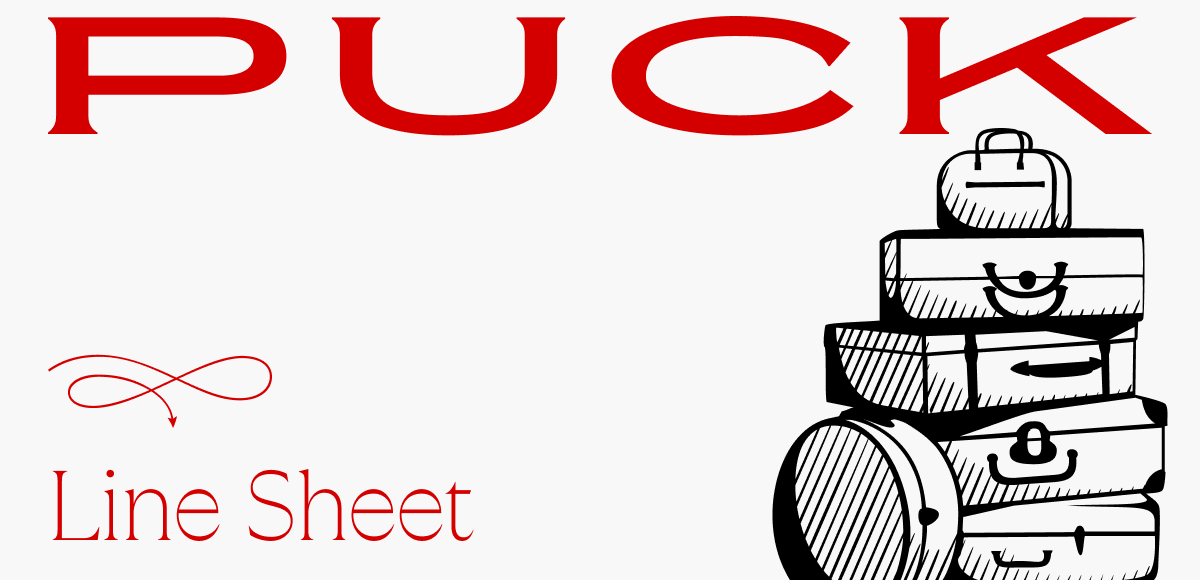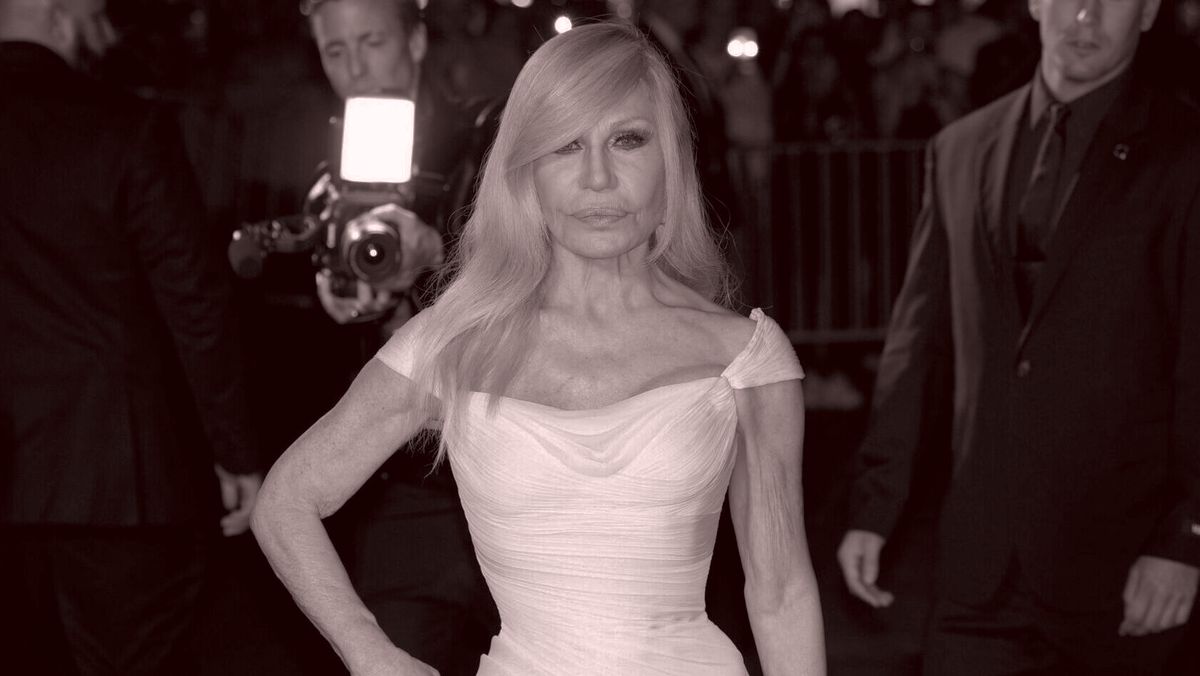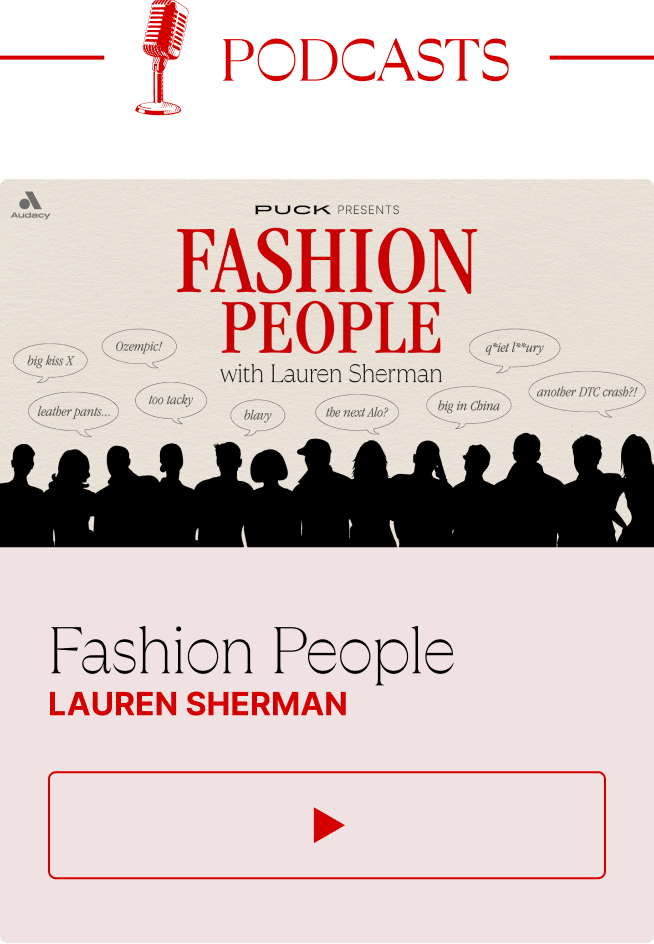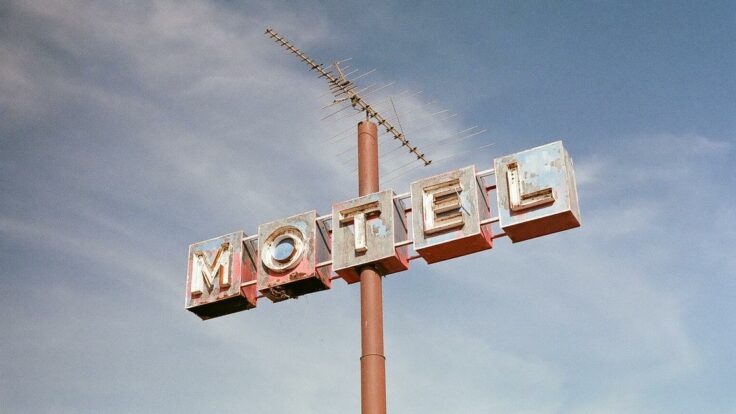Greetings! As you can probably tell, today’s newsletter looks a little different.
After three years, we’ve redesigned the look and feel of our private emails, and want to know what you think. If you have any feedback, please click here to take a brief survey.
|
Hi, and welcome back to Line Sheet. Santa Claus is this
close to coming to town, which means it’s time for a mailbag issue. Reply to this email with good questions for Rachel Strugatz, Sarah Shapiro, and yours truly. We’ll get to as many as possible.
Today, I dig into the complications at Versace as Capri preps the brand for a sale, and offer the requisite update from One World Trade. Plus, Sarah is here with some thoughts
on the Macy’s sitch (way interesting) and some data on what happens at retail when a designer switcheroo is announced.
🚨🚨 Programming note: Tomorrow on Fashion People, I’m joined by model/designer/stylist/shop-owner Tiina Laakkonen, whose beloved Amagansett store, Tiina, closed last year. We discussed Paris in the ’80s, London in the ’90s, New York in the aughts,
the Hamptons in the 2010s, and Karl Lagerfeld. She is incredible and I’m honored to have her on the pod. Listen here and here.
Mentioned in this
issue: Donatella Versace, Capri, Jimmy Choo, Macy’s, John Idol, Tony Spring, Louise Trotter, Matthieu Blazy, Blazy’s Sardine bag, Chanel, Bottega, Roger Lynch, Emmanuel Gintzburger, Jonathan Akeroyd, Burberry, Renzo Rosso, LVMH, Kering, Maison Margiela, Lina Khan, Roberta Benaglia, and many, many more…
|
Three Things You Should Know…
|
- No official party? No problem: Please, there’s no need to get nostalgic about the long-forgotten Condé Nast editor-in-chief and publisher holiday lunch at the Four Seasons with Si Newhouse, or the raucous holiday parties the individual magazines used to throw. Those are bygone days—but so too are the days when Condé Nast used to at least rent out Eataly. While it doesn’t sound like there’s going to be a company-wide holiday party this
year—the sales team toasted the end of the year in the building’s Empire Suite, a conference room with low ceilings straight out of a Cincinnati office tower—the word from One World Trade is that there are plenty of parties happening anyway, thanks to all the people who just got laid off but stayed through the end of the year and are choosing to celebrate their exits.
On Wednesday morning, those who are staying for 2025 were subjected to a speech delivered
virtually by C.E.O. Roger Lynch about the year ahead. (He shared some vague 2024 performance data, too.) At the end, Lynch fielded pre-vetted questions about the new four-days-in-office policy, which will be enforced beginning in March. Lynch, who chimed in from an undisclosed location, declined to say whether the new in-office mandate would apply to him.
I’m fairly unsympathetic to the people complaining about the policy—sitting face-to-face with someone can be
a revelation, and it’s really valuable in creative industries. But the big issue is that a lot of Condé employees moved outside the city during the pandemic, or took jobs at the company thinking that the policy was three days in-office. Now there will be extra transit and child care costs, not to mention time costs. Anyway, I’m told there is still some understandable confusion about the new roles on the revenue side, given all the layoffs and reorg, as well as plenty of remnant,
incurious editorial people still hoping that Santa Claus brings them back to the Four Seasons in 1998. Happy New Year!
|
|
|
A MESSAGE FROM OUR SPONSOR
|
PERFORMANCE UNLEASHED
With a distinct sporting personality, the Range Rover Sport is a
peerless performer.
EXPLORE
|
|
|

|
Sarah Shapiro
|
|
- What you need to know today about the chaos at Macy’s: I worked at Macy’s Inc. for more than a decade as a buyer for Bloomingdale’s, where I also developed the private label merchandise that was supposed to drive margin, but often ended up in the remainder bin. So I had a very proximate view of the multidecade decline of Macy’s, itself, which was first threatened by the rise of specialty retail in the early ’80s and then big box stores (Walmart, Target, etcetera) in
the ’90s, before Amazon even entered the picture and obviated much of the need for its 700 remaining stores—still a staggering number.
The group delayed the reporting of its third-quarter results because a now-fired employee apparently somehow hid about $150 million in delivery expenses over the course of a few years. Unsurprisingly, my group chats were on fire when the company announced this news, with ex-employees not only appalled, but also shocked that this sort of
accounting nit went unnoticed by the notoriously frugal, penny-pinching bean counters. When I worked at the group, I’d hear from the finance department if a vendor was even a few days late on a $25 charge-back—the money a brand has to pay a retailer if their product doesn’t sell for full price. (I’m not exaggerating.) So I’m still not sure how KPMG, Macy’s accounting firm since the ’80s, missed $150 million, even if it’s out of $4 billion in delivery expenses.
Anyway, the bigger problem for Macy’s is its continual descent in the ever-shrinking middle market. The real red flag in the earnings report was the fact that the company’s e-commerce revenue declined while the sector is growing rapidly. Meanwhile, activist investors Barington Capital, the guys who were behind the spinoff of Bath & Body Works from Victoria’s Secret, and Thor Equities are trying to carve out the good and bad assets. (The good: Bloomingdale’s, Sephora
competitor Blue Mercury, and of course, the real estate portfolio—including the Herald Square flagship, which is well-positioned amid the broader financial investment east of Hudson Yards. The bad: almost everything else…)
While the company rejected a $5.8 billion take-private offer at the beginning of this year, activists could push another deal. In the meantime, Macy’s needs to turn around its e-commerce business and reignite poorly performing stores. (Sixty-five locations are
scheduled to close after the holidays. By 2026, that number is expected to climb to 150, or 30 percent of the company’s current retail footprint.) Right now, sales at most stores aren’t growing. The company breaks out sales for the 50 top-performing stores, which grew 1.9 percent during the last quarter. That’s concerning, given that these are supposed to be the most productive locations.
The good news is that still-newish group C.E.O. Tony Spring is a company
lifer who had decades of success preserving and slowly pivoting Bloomingdale’s to survive in the hybrid marketplace. You have to wonder though, after this Saks-Neiman Marcus deal goes through, will HBC chairman Richard Baker come a-calling? I jumped on the phone with BMO analyst Simeon Siegel the other day to work out some theories regarding what happens next. The most likely scenario is that Bloomingdale’s and Blue Mercury are sold off and the money from the
sale is reinvested to fix Macy’s, but I don’t think we’re there yet. (Alas, Macy’s doesn’t own the flagship Bloomingdale’s building on 59th and Lex, which is part of the Joseph and Lyman Bloomingdale family trust.) If you know anything, or simply want to chat about the eternal existential crisis facing department stores, hit me up at SShapiro@puck.news.
- Does a designer’s exit really impact a brand’s topline at retail?: On resale sites, supply and demand can very much influence the “value” of items and drive price points and interest up. Last week, after Louise Trotter exited Carven for Bottega Veneta, and it was announced that Matthieu Blazy was leaving Bottega for Chanel, interest in these brands—even Carven!—spiked. The day of the announcement, searches for Carven
increased by 15 percent on eBay and week-over-week sales were up 13 percent on The RealReal. (Searches were up 28 percent.)
Most notably, on eBay, the average selling price of Blazy’s Sardine bag, which retails for $4,500, was up 35 percent month over month. (The RealReal can barely keep the Sardine and
Andiamo in stock, and that was pre-announcement.) For Carven, keep an eye on Trotter’s final collection on Net-a-Porter, where there’s a robust selection available. The first season especially was hard to find.
|
|
|
Capri C.E.O. John Idol is in a pickle in the wake of his failed
attempted merger with Tapestry, and now he’s looking to sell off assets like Versace. But questions surround the business that he acquired for $2.1 billion in 2018. Who will buy it? And at what price? And what will happen to Donatella?
|
|
|
Late last week, WWD reported that Capri, scrambling for
a Plan B after its failed merger with Tapestry, had engaged Barclays in an effort to sell off its two most relevant brands, Jimmy Choo and Versace. That’s not surprising: When the F.T.C. blocked the Tapestry deal, I predicted that both brands would likely “sell quickly—albeit for less than the price that Capri acquired
them, but at a reasonable number nonetheless.” I still believe that. Jimmy Choo, in particular, should have no trouble finding a buyer (shoes are a high-margin category). Versace, a strong brand with a weakening business, is a bigger strategic and creative challenge.
Versace was arguably overvalued when Capri C.E.O. John Idol bought the business in 2018 for more than $2.1 billion—2.5 times sales, but 22
times EBITDA. Of course, it was a great exit for Blackstone, which took a 20 percent stake in the company in 2014 at a $1.2 billion valuation. The deal also provided some liquidity to members of the Versace family, including Donatella, who has been designing the collection since her brother Gianni was murdered in 1997. But Versace, despite being one of the most recognized and revered fashion brands in the world, ultimately did
little for Capri’s bottom line.
|
|
|
A MESSAGE FROM OUR SPONSOR
|
PERFORMANCE UNLEASHED
With a distinct sporting personality, the Range Rover Sport is a
peerless performer.
EXPLORE
|
|
|
At the time of the acquisition, Idol told the press that he was
trying to build a U.S. version of LVMH—a familiar refrain that’s never worked, for both complex and yet entirely obvious reasons. In this case, Idol had built his company via masstige, not luxury, and he incorrectly presumed an infinite consumer capacity to buy handbags while acquiring a business, in Versace, that was first and foremost a clothing brand.
Also, Idol ostensibly did the right
thing by hiring Saint Laurent and Alexander McQueen alum Emmanuel Gintzburger after Versace C.E.O. Jonathan Akeroyd left for Burberry in 2021. Gintzburger was known for his exceptional taste and luxury expertise: At McQueen, he was able to ride the designer sneaker wave with a hit style that boosted the business for years. But Gintzburger ran into dual headwinds at Versace: first, the pandemic, which hurt sales in 2021; and then waiting on a merger that never
materialized. In the most recent fiscal quarter, sales were down 28 percent from a year earlier, with an operating loss of $3 million.
Changes in merchandising strategies (black one moment, print and classic silhouettes the next) haven’t helped, either. (Does Gintzburger understand the Versace D.N.A. and what the brand should be? Hard to know at this point.) Some seasons it’s good, other seasons it’s a nothingburger.
Versace sells a lot of robes and sunglasses.
And there’s the Donatella factor. The world-famous designer, who knows the brand better than anyone, signed a five-year deal with Idol when she sold the business. But Versace needs a succession plan beyond Donatella, who I’m told extended her contract in 2023. (A rep for Versace didn’t respond to a request for comment on this.) In an ideal world, Capri would bring on another designer to work in tandem with her, Raf
and Miuccia-style, but all these headaches—Covid, the attempted merger, and now a planned sale—have delayed anything from transpiring. Whoever buys Versace will have to reckon with a brand whose integrity is diminishing with consumers and requires not only an operational overhaul, but a creative transformation.
|
So who might be up for this turnaround? The world is very different
from when Capri snatched up Versace in 2018. Back then, the big strategic groups feasted on the notion of absorbing mid-sized brands that had the potential to reach several billion dollars in sales with the right capital investment. That doesn’t happen anymore.
Kering, which was allegedly interested in Versace before the Capri acquisition, has too much to fix at its own brands to take on another
turnaround. (And it’s already working on fully acquiring Valentino by 2028.) LVMH can never be ruled out—they care about good brands, and aren’t afraid of mess. But unlike Tiffany, Rimowa, or Loro Piana—three recent acquisitions that required overhauls—Versace is a pure fashion business, which means more seasonality and instability than fine jewelry, luggage, and cashmere. Richemont, once thought to be relinquishing interest in the fashion game, will certainly get a call from the Barclays guys,
especially after the success that fashion division C.E.O. Philippe Fortunato, who joined the company in 2020 from LVMH and Givenchy, has had reviving other small-ish fashion brands like Chloé and Alaïa.
One strategic group definitely interested in acquiring additional designer brands is Renzo Rosso’s OTB, which is still considering a public offering. Rosso is attempting to
position OTB as a haven for creative integrity. And while it may not be as well-resourced as LVMH or Kering or any of the big independents, Rosso aims to be incredibly sensitive to the needs of designers while achieving certain business goals. (See the way he managed Margiela under Galliano—spinning the classic silhouettes in a clever way to boost
sales, and making the secondary line super commercial while leaving Galliano to do what he pleased on the runway.)
|
|
|
Could Tapestry, Capri’s former deal partner on the blocked
merger, emerge as a stalking horse? The big problem with the merger was the Coach and Michael Kors of it all, and anyway, Lina Khan will be gone by then—good riddance. But my hunch is that Tapestry would prefer to acquire a U.S.-based company.
A private equity firm like L Catterton—or maybe Italy’s Style Capital—could also make a play. (It’s likely that Style Capital C.E.O.
Roberta Benaglia would partner with another firm on a purchase of this size, given the post-acquisition capital requirements.) And if it isn’t Catterton, others will be interested. After all, Versace is primed for this sort of investment and return profile. It’s a historic brand, still attached to a famous designer, operating under its recent trading value. You can be sure that the deal guys inside those midtown offices have this all spreadsheeted out,
presumably by leaning into beauty and fragrance, and even a little masstige, all while chipping in Donatella and allowing her to do her thing—before flipping the business in a few years to one of the aforementioned buyers.
In any of the above scenarios, Donatella would be required and incentivized to stay on during a transitional period of either three or five years. Her brand knowledge is unmatched, and she literally still
designs… even the prints. The only outcome in which Donatella’s presence would likely not be required is if an Authentic Brands Group, G-III, or WHP Global-type firm that specializes in brand management (or brand killing, depending on how you spin it) emerges triumphant—a buyer-of-last-resort scenario that would force Donatella, who turns 70 in May, to watch her work end up in the remainder bin. It wouldn’t be ideal for anyone involved; it’s not a good look, and would be a
flat-out acknowledgement that the Capri experiment failed. But remember that LVMH sold Donna Karan to G-III. Idol may simply not have a choice.
|
Congrats to Noah Johnson, the former GQ
deputy editor, who was named editor-in-chief of Highsnobiety. Noah’s great! The big question, of course, is: Will Evan Kinori start wholesaling to the Highsnob store? [BoF]
On the subject of department stores being taken private, seems like the
Nordstrom family is getting their wish! [WWD]
Everyone has been messaging me being like, Whoa! Vera Wang generates $700 million a year in sales? No, sillies! Her licenses generate $700 million in retail sales—that is the retail value of
the product shipped, not actual revenue. It’s still a good amount and impressive—love Vera—but it’s a cosmetic figure. As for whether it’s good that she sold to WHP? It’s good that she did what she wanted to do, and I hope she is happy. [WWD]
John McDonald, the owner of Lure Fishbar—that macho seafood place under the Prada store on the corner of Mercer and Prince that came into its powers during the Gawker era—has addressed the rumors that it’s closing to make room for a Prada café. Sounds like it’s probably going to happen, but that he is trying to stop it. I like it there and hope it sticks around, and I also love Prada.
[Eater]
I’m into Vogue’s Year in Fashion poll. It’s super fun and a spot-on depiction of what happened in the industry in 2024. [Vogue
Runway]
|
And finally… Whose panettone is the best
panettone?
Until Monday,
Lauren
|
|
|
Puck correspondent Lauren Sherman and a rotating cast of industry insiders take you deep inside what fashion
people are really talking about behind the scenes of this multi-trillion-dollar biz, from creative director switcheroos to M&A drama, D.T.C. downfalls, and magazine mishaps.
|
|
|
An insider-friendly tip sheet from Matthew Belloni, who spent 14 years in the trenches at The Hollywood Reporter
and five before that as an entertainment lawyer. Subscribers also receive What I’m Hearing+, a companion email focused on entertainment law, the streaming industry, and more.
|
|
|
Need help? Review our FAQ page or contact us for assistance. For brand partnerships, email ads@puck.news.
You received this email because you signed up to receive emails from Puck, or as part of your Puck account associated with . To stop receiving this newsletter and/or manage all your email preferences, click
here.
|
Puck is published by Heat Media LLC. 107 Greenwich St, New York, NY 10006
|
|
|
|















